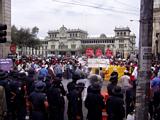Summary of events of 9 March against the DR-CAFTA in Guatemala
Summary of events against the CAFTA-DR in Guatemala 9 March
Autor(a): cmi mesoamerica
Fecha: Jueves 10 Marzo 2005
All night buses brought 250 protesters at six AM Wednesday from the northern state of Peten. The group waited in the central park for buses to arrive from other states. Protesters from yesterday said that police today were in redoubled force. Yesterday demonstrators had prevented the arrival of representatives to assemble a quorum. Representatives trying to depart were menaced.

This morning rural Guatemala spilled more farmers into the streets of the capital for the third day in a row, trying to block the Congress from ratifying the Free Trade Agreement with the United States. Last week 6,000 people protested in the same location for the same reason. More protests are expected.
All day Wednesday police maintained blockades two to three blocks from the Congress building, effectively cordoning off the representatives from contact with the protesters.
At nine AM about 500 men and 100 women walked to the blockade. Uniformed police formed a line across the street, two blocks from the Congress. They had clear plastic shields, black helmets and nightsticks. About 70 police blocked each of 4 crossings, and men in officer uniforms blocked two additional crossings.
After an hour the word passed through the group that the negotiations with demonstrators had been cut off. Demonstrators pushed into the line of police and nearly broke through. Shots were heard from near an armored truck at a distance of 100 yards behind the police line, and the police line ran. Tear gas exploded among the demonstrators and the armored truck shot blue stain onto the crowd and advanced. The protestors ran, turned back, ran, turned back and ran as the armored truck came forward.
Five people suffered blows from nightsticks. Two required sutures to the face and head; demonstrators themselves had brought suture and cared for the wounds in the central park. Four times ambulances were allowed to pass from the cordoned off area by the police and by demonstrators facing them. At four o’clock on Wednesday afternoon, two people from Peten are whereabouts unknown, in the words of the Guatemalans “disappeared”. They are not in the two city hospitals.
The protestors analyze clearly why they have journeyed far to run risks. Congress members who visited Peten in a “Mobile Cabinet” in 2004 promised to visit to consult with citizens about the Free Trade Agreement, and they didn’t. “Why? Why sign an agreement if we already have free trade?” “Peten and some smaller states in the north are the major agricultural producers in the country, and they will be very affected. Huge quantities of corn will enter Guatemala with no taxes, yellow corn, transgenic corn, contaminated corn.” Guatemala supplies its own demand for corn, the major staple in the diet here. Corn and other agricultural products will come from the United States where prices are low because of agricultural subsidies. Farmers here will not be able to sell their products.
A land use analyst based in the United States, Avrum Shriar at Virginia Commonwealth University, reports from his longitudinal studies that many farmers have less money and fewer cattle than they had 7 years ago. He observes that land is increasingly concentrated in fewer hands. Many small farmers have left agriculture in these recent years.
The Peten group wore red armbands. Many in the streets wore black or red. They carried sticks and chipped off curbstones and marched in protest against the Free Trade Agreement with United States. On the way to the action, one woman said, “La cosa esta seria, si trajo algo para defenderse, mejor.. Ya no estamos mirando a la paloma blanca. This is serious, if you brought something to defend yourself, all the better. We are not looking anymore at the white dove.” Another said, “We should have thrown lye or acid in the eyes of the police yesterday.” Another said, “What the government is making is another civil war.” “La hoya por mucho fuego al fin se rebalse el agua. Asi es el pueblo. The pot subjected to much fire, finally breaks and spills the water. Thus are the people.”
When asked “What is the Free Trade Agreement?” one man responded, “It is privatization of water and medicine.”
Banners from rural groups represented the Alliance for Peace and Life in Peten and others. In the afternoon, more groups arrived to march carrying banners from the , Alianza Civil para Acceso a Medicamentos, two groups represesenting HIV-positive people, National Organization of Students, GAM representing families of disappeared, union of workers in bottling plants and the government public health ministry.
The demonstrators stopped walking and marching at 4 pm. They have announced a national strike starting March 14.





